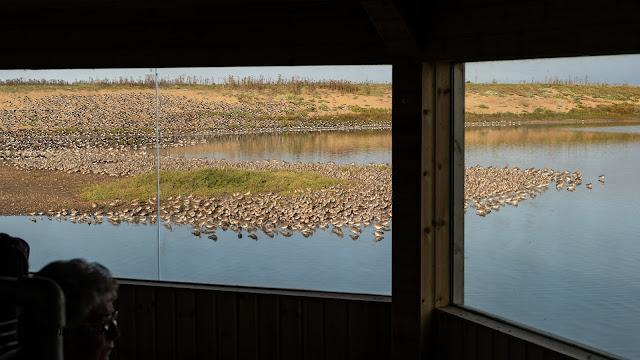September and it's officially "Autumn!" Where did the summer go?
But here we are, and at Snettisham the waders are back, and the tides are high. This morning, Saturday, September 2nd, I got up early and at 6.30 I was trudging along the two kilometre path to the RSPB Reserve, which, as the RSPB website informs us, consists of a variety of coastal habitats including lagoons, tidal mudflats, shingle beach and saltmarsh. These habitats form part of the wider Wash which is an internationally important area providing refuge for vast numbers of wildfowl and wading birds.
It is a lovely morning. The sun is already above the horizon, and, though the dawn was not very colourful, it is good light, catching the underwings of the whirling waders as they lift from the incoming tide.
There are tens of thousands of birds out there, feeding on the mudflats of the Ouse Estuary. By 25 past eight the tide will be tugged up to 7.8 metres high by the combined forces of the sun and the blue moon - that is 25.59 feet higher than mean sea level, and, though waders can swim, they can't feed when they are out of their depth so they come ashore to rest.
The majority of these birds are Knot (which, if you say it quickly, doesn't make sense, so don't.....) and there are around 265,000 of these on the shores of the British Isles during the winter months, having spent the breeding season in the Arctic (one could learn a thing or two there....) Knot are dumpy, short-legged, stocky wading birds (no comment). They form huge flocks in winter which wheel and turn in flight, flashing their pale underwings as they twist and turn. Some call these murmurations, though that word is more usually connected with starlings. A rather cute name for the flocking of Knot is "A Tangle," though one source refers to "A Cluster."
Whatever you like to call them, they fill the sky, almost covering the sun, and they fly overhead with a whirring of wings and excited peepings and twittering. (Not unlike politicians at the Division Bell....)
They aren't the only birds in these vast flocks though. Handsome white and black Oystercatchers, with their red beaks and scarlet stockings, abound as well, and at this time of year there are also thousands of Godwits, mainly bar-tailed, but also black-tailed, (and a name for them in profusion is fittingly "An Omniscience.")
The bar-tailed godwit is a long-billed, long-legged wading bird which breeds in the Scandinavian and Siberian Arctic, and hundreds of thousands of them pass through the UK, on their way further south, or stop off here for the winter. (Flying, as opposed to surface travel, being their preference....)
The waders come off the Wash as the tide rises, and hurry to find a spot on the shingle banks of the lagoons here. They hustle and shuffle and bluster and snuggle and soon they smother all available resting places.
They aren't the only ones having a rest though. Spoonbills and Cormorants may have picked the best spots, and there are geese, ducks and egrets around as well. All very cosmopolitan. Migration is a fact of life here, and ethnic diversity is accepted by all.
It's just that, for an hour or two, it is standing room only..... Every now and then there will be a crazy flurry of activity, and one lot will flap up and off and turn and return, and then it will be all ok again....
Then there'll be another alarm....
Then it will be calm again....
All snug
All tight in there - standing room only.....
While the human factor is kept in a glass box, quietly snapping away, wondering at how all these different creatures get on so well together.....
Pip! Pip! Some of us (?) really do have a lot to learn......
RSPB Snettisham, Beach Rd, Snettisham, King's Lynn PE31 7RA
And, as the RSPB says on its website:
On the biggest high tides from late summer onwards, tens of thousands of wading birds take flight as the incoming tide pushes them off the vast mudflats. We call this the 'whirling wader spectacle', a special event which doesn't happen everyday. Before travelling to the reserve to see this spectacle, we'd highly recommend you check our Snettisham Spectaculars Dates and Times Guide found in the downloads section below [on the website, y ken?]
From late summer to early winter tens of thousands of wading birds gather on the mudflats where they roost overnight. During an incoming tide, these birds are pushed closer to the beach and on a high spring tide vast flocks of knot, dunlin and oystercatchers take to the air en masse [excuse the French] as the high tides cover the mudflats. The commotion of thousands of wingbeats, excited calls and swirling flocks creates an exhilarating nature spectacle.
Arrest my case.....
Well I know 'cause I think about it all the time
I know that real love is hard to find
Maria Louisa McKee
















Lovely!
ReplyDeleteThis is enriching, as are all your essays. Thank you!
ReplyDelete